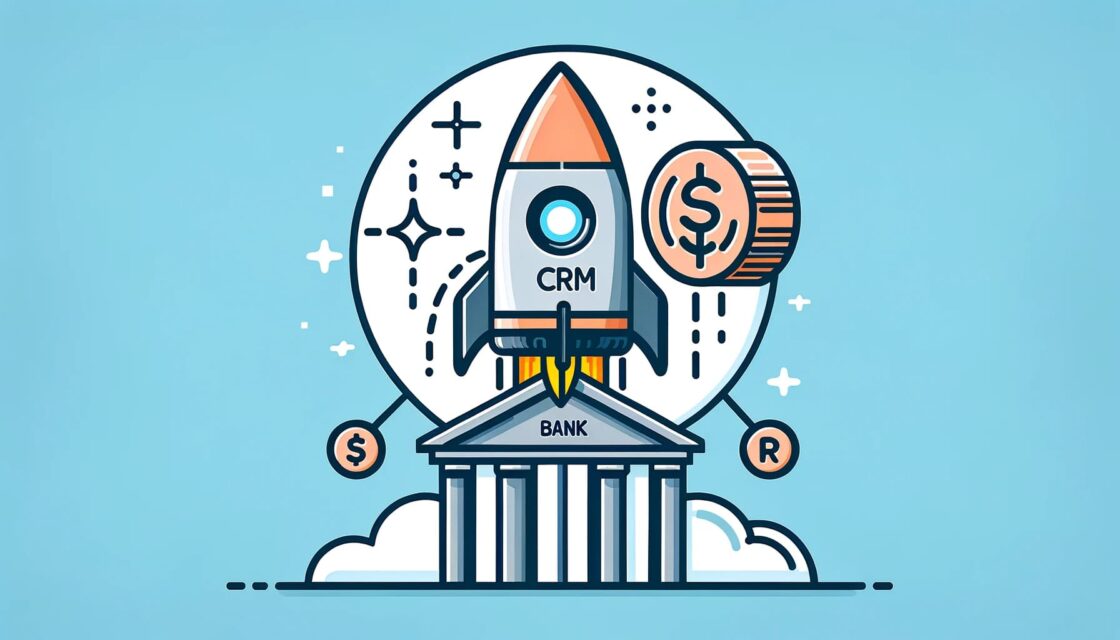
Customer relationship management (CRM) is essential in the banking industry. It serves as the backbone for maintaining customer loyalty and driving business growth. Effective CRM helps banks better understand their customers, providing insights that lead to improved services and stronger relationships. As competition intensifies and customer expectations evolve, banks must leverage advanced CRM strategies to stay ahead.
This post explores how banks can boost customer engagement and cut costs through effective CRM strategies. We will discuss modern techniques and technologies, including real-time analysis, hyperpersonalization, and marketing automation, that can transform banking CRM systems for enhanced customer interactions and operational efficiency.
The Evolving Landscape of Banking CRM
The landscape of banking CRM is rapidly changing, influenced by new technologies and evolving customer expectations. Current trends include a shift towards personalized, real-time interactions and a greater emphasis on using data analytics to understand customer behavior. Banks increasingly adopt omnichannel strategies to provide a seamless customer experience across various touchpoints, from in-person banking to mobile apps and online services.
Importance of Digital Transformation in Banking
Digital transformation is critical in this evolving landscape. Banks can leverage big data, artificial intelligence (AI), and machine learning to gain deeper insights into customer preferences and behaviors. These technologies enable banks to provide more personalized and efficient services, significantly enhancing customer satisfaction and loyalty. Digital transformation also helps banks streamline operations, reduce costs, and improve decision-making processes.
Role of IT and Marketing Professionals in CRM Strategy
The successful implementation of advanced CRM strategies requires close collaboration between IT and marketing professionals. IT teams play a vital role in integrating and managing the technological infrastructure needed for sophisticated CRM systems, while marketing professionals focus on leveraging these systems to create targeted and personalized customer interactions.
However, modern platforms are increasingly user-friendly, which reduces marketing’s dependence on IT for day-to-day operations. This shift allows marketing teams to execute campaigns more independently and efficiently while liberating IT from non-value activities, enabling them to focus on high-level tasks and challenges.
Boosting Customer Engagement
Banks must adopt advanced CRM strategies to foster stronger relationships and maintain customer loyalty. These strategies enhance customer engagement, streamline operations, and reduce costs.
Below are some key strategies banks can implement to boost customer engagement effectively. Implementing these strategies together as part of a comprehensive plan can yield even better results.
1. Understanding Customer Needs and Preferences
Engaging customers starts with a deep understanding of their needs and preferences. Collecting and analyzing customer data is essential. Key steps include:
- Collect Customer Data: Gather data from transaction histories, surveys, and social media interactions.
- Analyze Data: Use analytics to gain insights into customer behaviors and expectations.
- Segment Customers: Divide customers into groups based on shared characteristics to tailor marketing efforts.
A study by Salesforce found that 76% of customers expect companies to understand their needs and expectations (Salesforce, State of the Connected Customer, 2020).
Additionally, it is crucial to give customers control over their notification preferences. Allowing customers to choose what types of notifications they want to receive, when they want to receive them, and through which channels (e.g., email, SMS, push notifications) can significantly enhance their experience. This level of customization ensures that customers feel valued and heard, leading to higher satisfaction and loyalty.
2. Hyperpersonalization
Hyperpersonalization goes beyond traditional personalization by using advanced data analytics and machine learning to create highly individualized experiences. This might involve:
- Life Events: Offer tailored products based on significant life events (e.g., marriage, childbirth).
- Behavioral Data: Use browsing history and transaction data to send relevant offers and messages.
For example, a bank could send a personalized savings plan to a customer who recently had a baby based on their browsing and transaction history.
3. Real-Time Analysis and Decision Engines
Real-time data processing, particularly using transactional data, is crucial for delivering timely and relevant customer interactions. Benefits include:
- Immediate Responses: Provide instant alerts and notifications (e.g., fraud alerts, spending limit notifications).
- Decision Engines: Use tools like Latinia’s decision engine to analyze real-time transactional data for personalized offers and critical notifications.
For instance, a customer making a large purchase might receive a real-time alert about their spending limit or a special promotion related to their purchase.
4. Marketing Automation

Marketing automation simplifies customer engagement by automating repetitive tasks and campaigns. Advantages include:
- Automated Campaigns: Send scheduled email campaigns to inform customers about new products or services.
- Efficiency: Streamline marketing processes to ensure timely communication with customers.
While marketing automation efficiently handles pre-planned, recurring campaigns, it contrasts with real-time analysis and decision engines, which respond to immediate transactional events, providing a dynamic and responsive approach to customer interactions.
5. AI and Machine Learning
Artificial intelligence (AI) and machine learning are powerful tools in modern CRM strategies. They help by:
- Pattern Recognition: Analyzing vast amounts of data to identify patterns and predict future customer behaviors.
- Proactive Solutions: Using AI to anticipate customer needs, such as predicting when a customer might need a loan.
According to Accenture, AI could increase profitability rates by an average of 38% by 2035 (Accenture, Why Artificial Intelligence is the Future of Growth).
6. Omnichannel Communication
An omnichannel strategy ensures a seamless customer experience across all touchpoints. Key components include:
- Consistent Experience: Maintain consistency across online, mobile, and in-branch interactions.
- Integrated Systems: Ensure customer data is accessible and updated across all channels.
For example, Bank of America’s omnichannel strategy allows customers to interact through multiple channels seamlessly (Bank of America, Annual Report).
7. Customer Journey Mapping
Customer journey mapping helps identify and improve customer experiences. Steps include:
- Track Interactions: Monitor customer interactions at various stages.
- Identify Pain Points: Find and address issues that cause friction in the customer journey.
For instance, if customers frequently abandon online loan applications, the bank can streamline the process to improve completion rates.
8. Loyalty Programs and Rewards
Loyalty programs are effective for maintaining customer engagement. Benefits include:
- Incentives: Offer points, discounts, or exclusive services to encourage loyalty.
- Retention and Revenue: Studies show that loyalty programs can increase customer retention and revenue. According to a study by Bond Brand Loyalty, 71% of consumers say that loyalty programs make them more likely to continue doing business with brands. Additionally, a study by Harvard Business Review found that increasing customer retention rates by 5% increases profits by 25% to 95%.
For example, a bank might offer cashback rewards for using a particular credit card, enhancing customer satisfaction and loyalty.
Importance of Timely Communication and Critical Notifications
Effective communication is essential in building and maintaining customer relationships. In the banking industry, timely communication is crucial, especially when it comes to critical notifications. Here’s why timely communication and critical notifications matter:
1. Ensuring Timely and Relevant Communication
Banks must communicate with their customers promptly to address their needs and concerns. Timely communication can enhance customer satisfaction and build trust.
For example, sending immediate notifications about transaction updates or changes in account status can reassure customers that their bank is actively monitoring their accounts and protecting their interests.
Additionally, letting customers set their communication preferences can greatly improve their experience and satisfaction.
2. Role of Critical Notifications in Customer Engagement
Critical notifications play a vital role in customer engagement by providing important information at the right time. These notifications can include:
- Fraud Alerts: Instantly informing customers about suspicious activities on their accounts can prevent fraud and protect customer assets.
- Payment Reminders: Reminding customers about upcoming payments or due dates can help them avoid late fees and maintain good credit standing.
- Overdraft Alerts: Notifying customers when their account balance is low or overdrawn helps them take immediate action to avoid additional charges.
3. Benefits of Integrating Real-Time Data and Decision Engines
Integrating real-time data and decision engines can significantly improve the effectiveness of critical notifications. These systems can analyze real-time transactional data and trigger appropriate notifications based on predefined rules and customer behaviors.
For example, Latinia’s decision engine can enhance customer interactions by providing personalized offers and critical notifications based on real-time transactional data.
4. Enhancing Customer Trust and Loyalty
Providing timely, accurate information through critical notifications can enhance customer trust and loyalty. Customers are more likely to stay with a bank that proactively communicates important information and helps them manage their finances effectively.
By leveraging real-time data and decision engines, banks can ensure that their communication is timely and relevant, further strengthening customer relationships.
Reducing Costs in Banking CRM
In addition to boosting customer engagement, effective CRM strategies can help banks reduce operational costs. Here are key strategies to achieve cost savings in banking CRM:
1. Migrating from SMS to Push Notifications
One of the significant cost-saving measures for banks is migrating from SMS to push notifications. Push notifications offer several advantages over traditional SMS:
- Cost Efficiency: Push notifications are generally less expensive than SMS messages, especially when dealing with large volumes of messages.
- Higher Engagement Rates: Push notifications tend to have higher engagement rates because they are more visually appealing and interactive.
- Rich Media: Push notifications can include images, links, and other rich media, making them more engaging and informative.
2. Avoiding Irrelevant Messages
Sending irrelevant messages not only frustrates customers but also incurs unnecessary costs. By leveraging data analytics and customer segmentation, banks can ensure that they only send relevant and personalized messages to their customers. Strategies include:
- Customer Segmentation: Divide customers into segments based on their behaviors, declared preferences, and transaction histories.
- Targeted Messaging: Send tailored messages that are relevant to each customer segment, increasing the likelihood of engagement.
- Behavioral Triggers: Use customer behavior data to trigger contextually relevant and timely messages.
For example, if a customer frequently uses their credit card for travel expenses, the bank can send targeted offers related to travel insurance or foreign exchange services rather than generic promotions.
3. Streamlining Operations with Automation
Automation can significantly reduce operational costs by streamlining repetitive tasks and improving efficiency. Key areas where automation can help include:
- Automated Marketing Campaigns: Schedule and send marketing campaigns automatically, reducing the need for manual intervention.
- Customer Service Automation: Use chatbots and automated response systems to handle routine customer inquiries, freeing staff to handle more complex issues.
- Workflow Automation: Automate internal processes such as loan approvals and account openings to reduce processing time and costs.
By implementing these cost-saving strategies, banks can optimize their CRM operations, reduce unnecessary expenses, and enhance overall efficiency.
Conclusion
Implementing advanced CRM strategies is essential for banks aiming to enhance customer engagement and reduce operational costs. By understanding customer needs and preferences, leveraging hyperpersonalization, utilizing real-time analysis and decision engines, and incorporating marketing automation, banks can create a more personalized and efficient customer experience.
Furthermore, embracing technologies such as AI and machine learning, adopting omnichannel communication strategies, mapping customer journeys, and implementing loyalty programs can significantly boost customer satisfaction and retention.
Migrating from traditional SMS to push notifications offers a cost-effective and engaging way to communicate with customers. By sending timely and relevant notifications, banks can improve customer trust and loyalty while reducing communication costs.
Latinia’s products are specifically designed to support these advanced CRM strategies:
- Next Best Action (NBA): Latinia’s NBA solutions analyze customer data in real-time to identify and recommend the most relevant actions for each customer. This ensures that every interaction is personalized and timely, enhancing customer satisfaction and engagement.
- Subscription Engine: This tool allows customers to manage their notification preferences, choosing what types of notifications they want to receive, when they want to receive them, and through which channels (e.g., email, SMS, push notifications). By respecting customer preferences, banks can increase customer satisfaction and reduce the risk of notification fatigue.
- Critical Notification Gateway: Latinia’s critical notification gateway ensures that important messages, such as fraud alerts and payment reminders, are delivered promptly and reliably. This real-time communication capability is crucial for maintaining customer trust and preventing potential issues before they escalate.
Partnering with Latinia banks can streamline their operations, enhance customer engagement, and significantly reduce costs.
Ready to transform your CRM strategies and enhance customer engagement while reducing costs? Contact our experts at Latinia to learn how our innovative solutions can help you achieve your goals.
Reach out to us today to schedule a consultation.
Categories: Strategy

